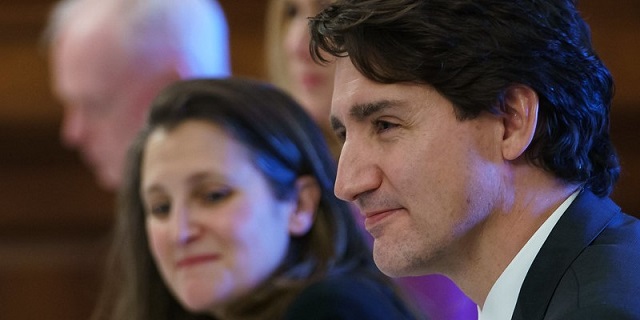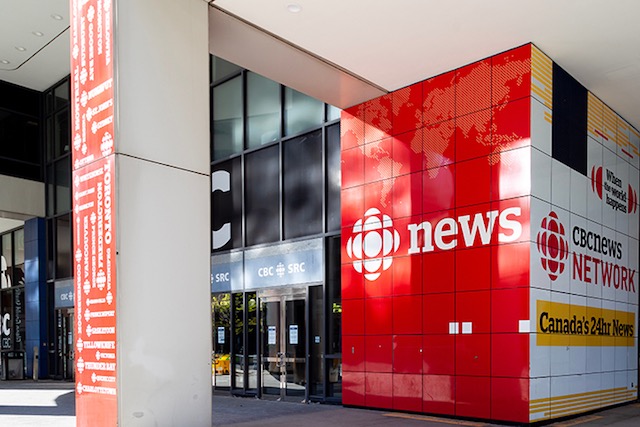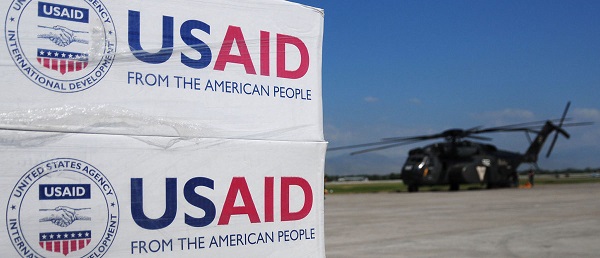Economy
Finance minister misleading Canadians about economic growth

From the Fraser Institute
By Jake Fuss and Grady Munro
Finance Minister Chrystia Freeland recently said Canada will have “the strongest economic growth in the G7.” But is that true? And are Canadians better off because of it?
The Trudeau government regularly uses comparisons among G7 countries (Canada, France, Germany, Italy, Japan, the United Kingdom and the United States) to gauge Canada’s economic performance. And when comparing economic growth in the aggregate (meaning overall growth, as measured by GDP), Minister Freeland is correct that Canada’s economy performs well compared to the rest of the G7.
Specifically, from 2000 to 2023, Canada’s average GDP growth (adjusted for inflation) was second-highest in the G7 at 1.8 per cent annually (only behind the U.S.). And in a recent report, the International Monetary Fund projected that Canada’s overall GDP growth will be second-highest in 2024, and lead the G7 in 2025.
But there’s a serious problem with these measures—they fail to account for population growth rates in each country and therefore don’t measure whether or not individuals are actually better off.
Simply put, economies grow when there are more people producing goods and services (i.e. the population grows) or when people are able to produce more per hour worked (i.e. productivity increases). In recent years, the Canadian economy has grown almost exclusively due to population growth, which has grown at historic rates due to record levels of immigration, while productivity has declined to the point it’s now considered an emergency.
In fact, from 2000 to 2023, Canada led the G7 in average annual population growth, which has served to inflate the country’s rate of aggregate GDP growth.
So, to more accurately measure Canada’s economic performance relative to other countries, economists use GDP per person, which accounts for differing population growth rates. This measure is a much better indicator of individual incomes and living standards.
On this measure, Canada is an economic laggard. Canada’s average annual growth rate in GDP per person (inflation-adjusted) from 2000 to 2023 was 0.7 per cent—tied for second-last in the G7, above only Italy (0.1 per cent).
If you include a broader subset of advanced economies, and focus on the Trudeau government’s tenure, the picture is even worse. From 2014 to 2022 (the latest year of available data), Canada was tied for the third-lowest average annual growth rate in inflation-adjusted GDP per person out of 30 countries in the Organisation for Economic Cooperation and Development (OECD). Canada’s average growth rate during that period (0.6 per cent) was only ahead of Luxembourg (0.5 per cent) and Mexico (0.4 per cent).
Looking ahead, Canada’s long-term economic prospects are similarly dismal. According to the OECD, Canada is expected to see the lowest average annual growth rate in GDP per person in the OECD, from 2020 to 2030 and 2030 to 2060.
When Minister Freeland boasts about aggregate GDP numbers—while ignoring how historic levels of population growth fuelled by record-high immigration inflate the numbers—she’s misleading Canadians. In reality, Canadian living standards are falling behind the rest of the developed world, and are expected to fall further behind in years to come.
Authors:
Business
Most Canadians say retaliatory tariffs on American goods contribute to raising the price of essential goods at home

- 77 per cent say Canada’s tariffs on U.S. products increase the price of consumer goods
- 72 per cent say that their current tax bill hurts their standard of living
A new MEI-Ipsos poll published this morning reveals a clear disconnect between Ottawa’s high-tax, high-spending approach and Canadians’ level of satisfaction.
“Canadians are not on board with Ottawa’s fiscal path,” says Samantha Dagres, communications manager at the MEI. “From housing to trade policy, Canadians feel they’re being squeezed by a government that is increasingly an impediment to their standard of living.”
More than half of Canadians (54 per cent) say Ottawa is spending too much, while only six per cent think it is spending too little.
A majority (54 per cent) also do not believe federal dollars are being effectively allocated to address Canada’s most important issues, and a similar proportion (55 per cent) are dissatisfied with the transparency and accountability in the government’s spending practices.
As for their own tax bills, Canadians are equally skeptical. Two-thirds (67 per cent) say they pay too much income tax, and about half say they do not receive good value in return.
Provincial governments fared even worse. A majority of Canadians say they receive poor value for the taxes they pay provincially. In Quebec, nearly two-thirds (64 per cent) of respondents say they are not getting their money’s worth from the provincial government.
Not coincidentally, Quebecers face the highest marginal tax rates in North America.
On the question of Canada’s response to the U.S. trade dispute, nearly eight in 10 Canadians (77 per cent) agree that Ottawa’s retaliatory tariffs on American products are driving up the cost of everyday goods.
“Canadians understand that tariffs are just another form of taxation, and that they are the ones footing the bill for any political posturing,” adds Ms. Dagres. “Ottawa should favour unilateral tariff reduction and increased trade with other nations, as opposed to retaliatory tariffs that heap more costs onto Canadian consumers and businesses.”
On the issue of housing, 74 per cent of respondents believe that taxes on new construction contribute directly to unaffordability.
All of this dissatisfaction culminates in 72 per cent of Canadians saying their overall tax burden is reducing their standard of living.
“Taxpayers are not just ATMs for government – and if they are going to pay such exorbitant taxes, you’d think the least they could expect is good service in return,” says Ms. Dagres. “Canadians are increasingly distrustful of a government that believes every problem can be solved with higher taxes.”
A sample of 1,020 Canadians 18 years of age and older was polled between June 17 and 23, 2025. The results are accurate to within ± 3.8 percentage points, 19 times out of 20.
The results of the MEI-Ipsos poll are available here.
* * *
The MEI is an independent public policy think tank with offices in Montreal, Ottawa, and Calgary. Through its publications, media appearances, and advisory services to policymakers, the MEI stimulates public policy debate and reforms based on sound economics and entrepreneurship.
Business
Trump confirms 35% tariff on Canada, warns more could come

Quick Hit:
President Trump on Thursday confirmed a sweeping new 35% tariff on Canadian imports starting August 1, citing Canada’s failure to curb fentanyl trafficking and retaliatory trade actions.
Key Details:
- In a letter to Canadian Prime Minister Mark Carney, Trump said the new 35% levy is in response to Canada’s “financial retaliation” and its inability to stop fentanyl from reaching the U.S.
- Trump emphasized that Canadian businesses that relocate manufacturing to the U.S. will be exempt and promised expedited approvals for such moves.
- The administration has already notified 23 countries of impending tariffs following the expiration of a 90-day negotiation window under Trump’s “Liberation Day” trade policy.
Diving Deeper:
President Trump escalated his tariff strategy on Thursday, formally announcing a 35% duty on all Canadian imports effective August 1. The move follows what Trump described as a breakdown in trade cooperation and a failure by Canada to address its role in the U.S. fentanyl crisis.
“It is a Great Honor for me to send you this letter in that it demonstrates the strength and commitment of our Trading Relationship,” Trump wrote to Prime Minister Mark Carney. He added that the tariff response comes after Canada “financially retaliated” against the U.S. rather than working to resolve the flow of fentanyl across the northern border.
Trump’s letter made clear the tariff will apply broadly, separate from any existing sector-specific levies, and included a warning that “goods transshipped to evade this higher Tariff will be subject to that higher Tariff.” The president also hinted that further retaliation from Canada could push rates even higher.
However, Trump left the door open for possible revisions. “If Canada works with me to stop the flow of Fentanyl, we will, perhaps, consider an adjustment to this letter,” he said, adding that tariffs “may be modified, upward or downward, depending on our relationship.”
Canadian companies that move operations to the U.S. would be exempt, Trump said, noting his administration “will do everything possible to get approvals quickly, professionally, and routinely — In other words, in a matter of weeks.”
The U.S. traded over $762 billion in goods with Canada in 2024, with a trade deficit of $63.3 billion, a figure Trump called a “major threat” to both the economy and national security.
Speaking with NBC News on Thursday, Trump suggested even broader tariff hikes are coming, floating the idea of a 15% or 20% blanket rate on all imports. “We’re just going to say all of the remaining countries are going to pay,” he told Meet the Press moderator Kristen Welker, adding that “the tariffs have been very well-received” and noting that the stock market had hit new highs that day.
The Canadian announcement is part of a broader global tariff rollout. In recent days, Trump has notified at least 23 countries of new levies and revealed a separate 50% tariff on copper imports.
“Not everybody has to get a letter,” Trump said when asked if other leaders would be formally notified. “You know that. We’re just setting our tariffs.”
-

 Business19 hours ago
Business19 hours agoMost Canadians say retaliatory tariffs on American goods contribute to raising the price of essential goods at home
-

 National1 day ago
National1 day agoWomen and girls beauty pageant urges dismissal of transgender human rights complaint
-

 Alberta19 hours ago
Alberta19 hours agoCross-Canada NGL corridor will stretch from B.C. to Ontario
-

 International2 days ago
International2 days agoSupport for the Ukraine war continues because no one elected is actually in charge.
-

 Business2 days ago
Business2 days agoTrump slaps Brazil with tariffs over social media censorship
-

 Business2 days ago
Business2 days agoCBC six-figure salaries soar
-

 Business20 hours ago
Business20 hours agoB.C. premier wants a private pipeline—here’s how you make that happen
-

 Addictions2 days ago
Addictions2 days agoCan addiction be predicted—and prevented?






